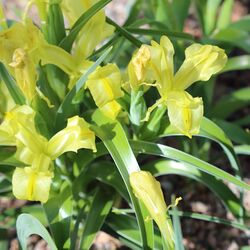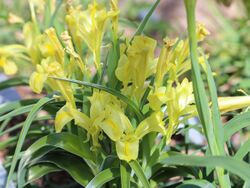Biology:Iris maracandica
| Iris maracandica | |
|---|---|

| |
| Scientific classification | |
| Kingdom: | Plantae |
| Clade: | Tracheophytes |
| Clade: | Angiosperms |
| Clade: | Monocots |
| Order: | Asparagales |
| Family: | Iridaceae |
| Genus: | Iris |
| Subgenus: | Iris subg. Scorpiris |
| Section: | Iris sect. Scorpiris |
| Species: | I. maracandica
|
| Binomial name | |
| Iris maracandica Vvedenski (Wendelbo)
| |
| Synonyms[1] | |
|
Juno maracandica (Vved). | |
Iris maracandica is a species in the genus Iris, it is also in the subgenus Scorpiris. It is a bulbous perennial from Uzbekistan, Central Asia. It has short stems, scented spring flowers in shades of yellow.
Description
Iris maracandica is similar in form to Iris bucharica.[2] It has bulb (approx.) 2 cm in diameter, with thickened fusiform roots (spindle-like).[3]
It has falcate shaped leaves, that are 1.5 – 2 cm wide close to the base of the plant.[3] The leaves have a silver edge.[2] It is small species with the Juno genus, growing up to a height of 15–18 cm (6–7 in) tall.[2][4]
It has 1-4 strongly scented flowers per stem, which bloom between March and April.[3][2][4]
The flowers come in a range of shades of yellow, from pale yellow,[4] to soft yellow,[2] and rich-yellow.[5] The perianth tube generally is about 3 – 4.5 cm long.[3] It has falls that have a wide wing and a raised pale yellow crest, the standards are short and deflexed.[6]
It has whitish anthers and pollen.[3]
Taxonomy
It was originally published as Juno maracandica by Alexei Vvedenski in 'Sched. Herb. Fl. As. Med. ' No. 662 in 1935.[3] It was then published in 'Fl. Tadzhikskoi 'SSR 2: on page 393 in 1963.[7]
It is named after 'Maracanda' (the Greek name for the city of Samarkand), in Tajikistan.[8]
It was then published as Iris maracandica in 'Botaniska Notiser' Vol 128(2) page 216 in 1975 by Wendlbo.[9]
Iris maracandica is now an accepted name by the RHS.[10]
Native
Iris maracandica is found on the gravelly slopes in foothills of Central Asia.[3][4] Found on the Pamir Mountains,[5] and Nuratau Mountains of Uzbekistan.[6][11]
It can be found near Dzhizak (now Jizzakh), Samarkand and Akrabat (in Uzbekistan).[3]
Cultivation
It can be cultivated outside in well-drained soils, not needing the protection of a bulb frame or alpine house, in the UK.[5]
References
- ↑ "Juno maracandica (Vved)". www.theplantlist.org. 23 March 2012. http://www.theplantlist.org/tpl/record/kew-322998.
- ↑ 2.0 2.1 2.2 2.3 2.4 Austin, Claire (2005). Irises A Garden Encyclopedia. Timber Press. p. 300. ISBN 0-88192-730-9. https://archive.org/details/irisesgardenerse00aust_669.
- ↑ 3.0 3.1 3.2 3.3 3.4 3.5 3.6 3.7 Komarov, V.L. (1935). "Akademiya Nauk SSSR (FLORA of the U.S.S.R.) Vol. IV". https://archive.org/stream/floraofussr04bota/floraofussr04bota_djvu.txt.
- ↑ 4.0 4.1 4.2 4.3 Cassidy, G.E.; Linnegar, S. (1987). Growing Irises (Revised ed.). Bromley: Christopher Helm. p. 147. ISBN 0-88192-089-4.
- ↑ 5.0 5.1 5.2 "Iris maracandica". rareplants.co.uk. http://rareplants.co.uk/product.asp?strParents=192&CAT_ID=108&P_ID=603.
- ↑ 6.0 6.1 "Iris maracandica". signa.org (Species Iris Group of North America). 12 July 2012. http://www.signa.org/index.pl?Iris-maracandica.
- ↑ "Juno maracandica Vved". theplantlist.org. http://www.theplantlist.org/tpl/record/kew-322998.
- ↑ Aisha KhanA Historical Atlas of Uzbekistan, p. 17, at Google Books
- ↑ "Iris maracandica". ipni.org (International Plant Names Index). http://www.ipni.org/ipni/idPlantNameSearch.do?id=438846-1.
- ↑ "Iris vicaria". www.rhs.org.uk. https://www.rhs.org.uk/Plants/9315/Iris-maracandica/Details.
- ↑ Ruksans, Janis (2010). "Re: Juno (Scorpiris) - Season 2010". srgc.net. http://www.srgc.net/forum/index.php?topic=4764.165.
External links
Wikidata ☰ Q15571329 entry
 |


